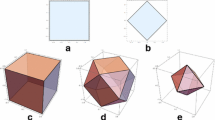Abstract
Based on the Study displacive theory that there is a one-to-one correspondence between an oriented straight line in three-dimensional Euclidean space (E 3) and a dual point on the surface of a dual unit sphere (DUS) in three-dimensional dual space (D 3), this paper presents a new methodology for the generation of ruled surfaces by planning (fitting or interpolating) the motion locus of a point on the surface of a DUS and discusses its applications in engineering. Some geometric problems and an optimal generation model for ruled surfaces are dealt with in detail. The correctness and effectiveness of this methodology are illustrated by examples and application in practice.
Similar content being viewed by others
References
Q. L. Ding and B. J. Davies,Surface Engineering Geometry for Computer Aided Design and Manufacture, Ellis Horwood, Halsted Press, 1987.
J. P. Kruth and R. Snoeys, “A generalized post-process-planner for five-axis wire EDM machines”,Annals of the CIRP,37(1), pp. 203–208, 1988.
H. Q. Lu and T. W. Sze, “Description of a class of surfaces for 3D recognition”,Proceedings, 1988 IEEE International Conference on Systems, Man, and Cybernetics, Shenyang, PR China, pp. 1113–1116, 1988.
X. F. Zha, “Research on the harmonious planning and simulation of the trajectory of robot end effector”,Proceedings, the 9th International Conference on Computer Aided Production Engineering, Nanjing, PR China, pp. 296–301, 1993.
O. Gursoy, “Some results on closed ruled surfaces and closed space curves”,Mechanism and Machine Theory,27(3), pp. 323–330, 1992.
E. H. Bokelberg, K. H. Hunt and P. R. Ridely, “Spatial motion—I: acceleration and the differential geometry of screws”,Mechanism and Machine Theory,27(1), pp. 1–15, 1992.
P. R. Ridely, E. H. Bokelberg and K. H. Hunt, “Spatial motion—II: acceleration and the differential geometry of screws”,Mechanism and Machine Theory,27(1), pp. 17–35, 1992.
X. F. Zha, M. Wang, Albert Choi, “Optimal trajectory planning for robot manipulators”,Proceedings, 2nd Asian Conference on Robotics and its Application, Beijing, China, pp. 570–575, 1994.
E. Study,Geometrie der Dynamen, Leipzig, 1903.
B. Ravani and B. Roth, “Mapping of spatial kinematics”,ASME Journal of Mechanical Transmissions, and Automation in Design,106(3), pp. 341–347, 1984.
J. Duffy,Analysis of Mechanisms and Robot Manipulators, Wiley, 1980.
J. Ahlberg, E. Nilson and J. Walsh,The Theory of Splines and their Applications, Academic Press, 1967.
A. W. Nutbourne and R. R. Martin,Differential Geometry Applied to Curve and Surface, Ellis Horwood, Halsted Press, 1988.
P. Dierckx,Curve and Surface Fitting with Splines, Oxford University Press, 1993.
T. Duffy, “Quaternion splines for animating orientation”,Technical Report, AT&T Bell Laboratories, 1986.
X. F. Zha and M. Wang, “Theory of planning generation of ruled surface and its applications in CAD/CAM”,Proceedings, 2nd International Conference on Manufacturing Technology, Hong Kong, pp. 253–258, 1993.
R. S. Millman and G. D. Parker,Elements of Differential Geometry, Prentice-Hall, Englewood Cliffs, New Jersey, 1977.
P. J. Besl and R. C. Jain, “Invariant surface characteristics for 3D object recognition in range images”,Computer Vision, Graphics and Image Process,33(1), pp. 33–80, 1986.
M. Brady, J. Ponce, A. Yuille and H. Asada, “Describing surfaces”,Computer Vision, Graphics and Image Process,32(1), pp. 1–28, 1985.
X. F. Zha and W. M. Jin, “Screw method of robot end effector generation”,Journal of Southeast University (English version),8(1), pp. 116–123, 1992.
PCEMSS, CAD Center, Huazhong University of Science and Technology, PR China, 1990.
K. H. Hunt,Kinematic Geometry of Mechanisms, Clarendon Press, Oxford, 1978.
G. Farin (ed.), NURBS for Curve & Surface Design, Society for Industrial & Applied Mathematics, 1991.
Author information
Authors and Affiliations
Rights and permissions
About this article
Cite this article
Zha, X.F. A new approach to generation of ruled surfaces and its applications in engineering. Int J Adv Manuf Technol 13, 155–163 (1997). https://doi.org/10.1007/BF01305867
Issue Date:
DOI: https://doi.org/10.1007/BF01305867




